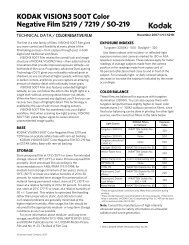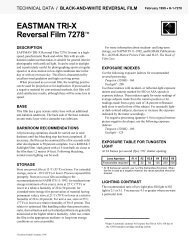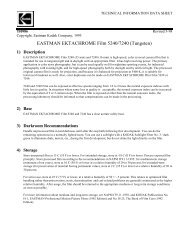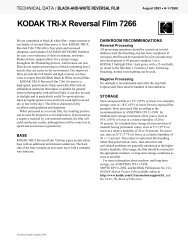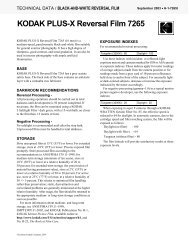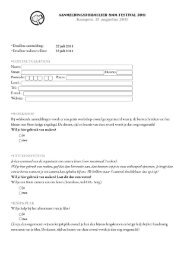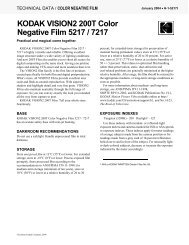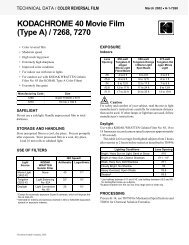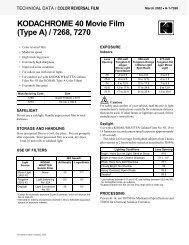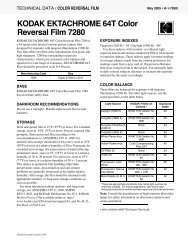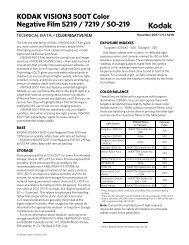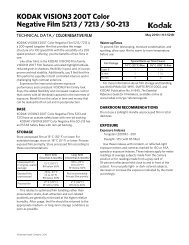FUJICHROME ASTIA 100F Professional [RAP100F] - Wittner ...
FUJICHROME ASTIA 100F Professional [RAP100F] - Wittner ...
FUJICHROME ASTIA 100F Professional [RAP100F] - Wittner ...
You also want an ePaper? Increase the reach of your titles
YUMPU automatically turns print PDFs into web optimized ePapers that Google loves.
FUJIFILM PRODUCT INFORMATION BULLETIN • <strong>FUJICHROME</strong> <strong>ASTIA</strong> <strong>100F</strong> <strong>Professional</strong> [RAP<strong>100F</strong>]<br />
• A UV filter No. 2C* (SC-39 or SC-40)** or other appropriate<br />
ultraviolet absorbing filter is recommended<br />
for scenes that are shone upon by strong<br />
ultraviolet light, such as seaside locations, snow<br />
scenes, and bright distant views.<br />
• Excessively high or low color temperatures may require<br />
the following filters and exposure corrections.<br />
Subject Conditions<br />
High Color Temperature:<br />
Cloudy weather landscapes or<br />
portraits in open shade in clear<br />
weather.<br />
Low Color Temperature:<br />
Morning and evening twilight<br />
scenes and portraits.<br />
Filter<br />
No.81A*<br />
(LBA-2)***<br />
No.82A* or<br />
No.82C* (LBB-2<br />
or LBB-4)***<br />
Exposure<br />
Correction<br />
+1/3<br />
stop****<br />
+1/3 to<br />
+2/3<br />
stop****<br />
* Wratten Filter<br />
** Fuji Sharp-cut Filter<br />
*** Fuji Light Balancing Filter (not available in certain markets.)<br />
**** A “+” followed by a number indicates the required increase in<br />
lens opening.<br />
Electronic Flash<br />
• Electronic flash produces light similar to daylight, so<br />
filters are not needed. However, the possibility of undesirable<br />
effects on color balance, due to various<br />
factors (differences in equipment, use duration, etc.)<br />
should be taken into consideration. Test exposures<br />
are recommended.<br />
• The use of a flash meter is advisable, but the following<br />
formula can also be used to obtain a satisfactory<br />
lens opening.<br />
Lens<br />
Electronic Flash Guide Number (at ISO 100)<br />
Aperture =<br />
(F-number) Electronic Flash-to-Subject Distance (meters or feet)<br />
• Set the film speed at ISO 100. Since the amount of<br />
light reflected onto the subject from surrounding surfaces<br />
will differ with the conditions, refer to the flash<br />
unit instructions.<br />
Daylight Photoflood / Photo-Reflector Lamps<br />
• Daylight-type photoflood or photo-reflector lamp output<br />
may be lower than that indicated by an exposure<br />
meter, so it is advisable to compensate for this by increasing<br />
exposure time or lens opening. Whenever<br />
possible, test exposures are recommended.<br />
• Other factors requiring consideration when determining<br />
the exposure time are lamp configuration, use<br />
duration and line voltage, as they may affect lamp<br />
output and color balance<br />
Fluorescent Lamps<br />
• The use of the following combinations of color compensating<br />
filters is advisable when photographing<br />
under fluorescent lighting.<br />
• For exacting work, however, test exposures are recommended<br />
because lamp brand and age may affect<br />
light output and color balance.<br />
– 2 –<br />
Fluorescent<br />
Lamp Type<br />
Color<br />
Compensating<br />
Filters*<br />
Exposure<br />
Corrections**<br />
White<br />
(W)<br />
10B+5M<br />
+1/2 stop<br />
Daylight<br />
(D)<br />
25R<br />
+1 stop<br />
Cool White<br />
(CW)<br />
15M+5B<br />
+2/3 stop<br />
Warm White<br />
(WW)<br />
No. 80C+10M<br />
+1 stop<br />
(Exposure time: 1/2 sec.)<br />
* Wratten Color Compensating Filters or Fuji Color Compensating<br />
Filters are recommended.<br />
NOTE: No. 80C is a Wratten Color Conversion Filter.<br />
** Exposure correction values when using a filter relative to unfiltered<br />
exposure results. A “+” followed by a number indicates the<br />
required increase in lens opening.<br />
NOTES<br />
• Use a shutter speed slower than 1/30 second.<br />
• For shutter speeds of 2 minutes or more, exposure adjustments<br />
will be necessary to compensate for reciprocity law failure.<br />
Tungsten Lamps<br />
• A Wratten Filter No.80A (or Fuji Light Balancing Filter<br />
LBB-12) is required when using 3200K tungsten lighting.<br />
A 1 2 /3-stop larger lens opening is also required.<br />
• If household tungsten lighting (room lamps, etc.)<br />
constitutes the main source of illumination, in addition<br />
to the above filter a Wratten Filter No.82A (or Fuji<br />
Light Balancing Filter LBB-2) is required, plus an aperture<br />
increase of 1/3 stop (total 2 stops).<br />
Mixed Light Sources<br />
Under mixed light conditions, the basic filter configuration<br />
should suit the main light source. In the case of<br />
cameras with TTL metering, there is no need for additional<br />
exposure compensation for any CC filter(s) used.<br />
5. LONG AND MULTIPLE EXPOSURE<br />
COMPENSATION<br />
No exposure correction or color balance compensation<br />
is required for exposures within a shutter speed range of<br />
1/4000 second to 1 minute. However, for exposures of 2<br />
minutes or longer, ‘reciprocity law failure’-related color<br />
balance and exposure compensations are required.<br />
Exposure Time 1/4000 sec. – 1 min.<br />
Color Compensating<br />
Filter<br />
None<br />
Exposure<br />
Corrections*<br />
2 min.<br />
5B<br />
+ 1/3<br />
stop<br />
4 min.<br />
5B<br />
+ 1/2<br />
stop<br />
8 min.<br />
5B<br />
+ 2/3<br />
stop<br />
* Exposure correction values when using a filter relative to unfiltered<br />
exposure results. A “+” followed by a number indicates the required<br />
increase in the lens opening.<br />
Multiple Exposures<br />
No exposure correction or color balance compensation<br />
is required for up to eight consecutive multiple exposures<br />
using an electronic flash.<br />
NOTE<br />
Exposure correction values given above for long and<br />
multiple exposures are for a reversal film with an average<br />
emulsion when processed under standard processing<br />
conditions. Therefore, use the data only as a<br />
guide. For exacting work, test exposures are recommended<br />
under actual shooting conditions.


![FUJICHROME ASTIA 100F Professional [RAP100F] - Wittner ...](https://img.yumpu.com/27567144/2/500x640/fujichrome-astia-100f-professional-rap100f-wittner-.jpg)
